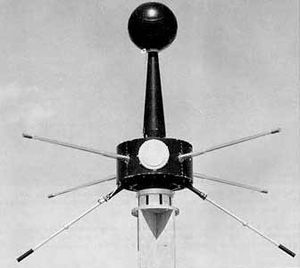Explorer 10
| Explorer 10 | |
|---|---|

|
|
| Type: | Research satellite |
| Country: |
|
| Operator: |
|
| COSPAR-ID : | 1961-010A |
| Mission dates | |
| Dimensions: | 79 kg |
| Begin: | March 25, 1961, 15:17 UTC |
| Starting place: | Cape Canaveral , LC-17 |
| Launcher: | Thor Delta |
| Status: | out of service since March 27, 1961 |
| Orbit data | |
| Rotation time : | 83.5 min |
| Orbit inclination : | 33 ° |
| Apogee height : | 180,999 km |
| Perigee height : | 220 km |
| Eccentricity : | 0.89132 |
Explorer 10 was a satellite of the US space agency NASA as part of the Explorer program . The aim of the mission was to investigate the geomagnetic field and solar corpuscular radiation . Explorer 10 was brought into a highly elliptical orbit and was spin stabilized .
Due to its battery power supply, the satellite was designed for a service life of just 52 hours. He sent data throughout the mission. The latest information was sent from a distance of 42.3 Earth radii. It was the first satellite that could measure the shock wave of a solar flare.
swell
- Herbert Pfaffe, Peter Stache: spacecraft. A type book , 1972
- Explorer 10 in the NSSDC (English)
- Explorer 10, article on the website of the Goddard Space Flight Center (English)
Individual evidence
- ↑ Explorer 10 - Launch Information in the NSSDCA Master Catalog , accessed November 27, 2014.
